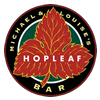Month: August 2018
Hopleaf History—Chapter 3—Michael’s History in Bars—The Bronx
Every bar that I worked at left me with something valuable to take with me in life and in the business and culture of bar ownership. Every bar has a plethora of stories too. So it was with The Bronx Bar, on the corner of 2nd Ave and Prentis. I actually worked there twice, leaving and returning when something else did not pan out.
My boss at the Bronx was a Lebanese man, George Jordan. He had started working at the Bronx in 1942 and eventually bought not only the bar, but many of the 3 story walk up apartment buildings that lined Prentis on both sides of Second Avenue. Detroit is a city of owner occupied single family homes with driveways and garages and this area is one of the few in the city with dense, truly urban apartment buildings, most from the late 19th Century. Most of Detroit has never looked like a big city. This area does.

The Bronx is a one story corner saloon that like most in big cities covered all or most of its windows. What people who know the Bronx will always tell you about its appearance is to describe it’s 1930’s art deco neon sign. Bright red, it illuminates the corner even today.
George was a soft spoken man, short and round. While not intimidating, he knew who he did and did not want in his place. Never married, his life was the Bronx Bar. He had some employees who had been working there for many decades. One waitress worked into her 80’s. Dave, an ex jockey with a mostly cranky demeanor, had worked there for over 20 years. I worked with him a lot. Like most jockeys, he was very short. He reveled in telling how even though he was a little guy he could throw out any customer who’d worn out his welcome because he’d wrested control of 900 pound horses in his time. He’d act out bonding the reigns with flexed forearms. He also showed anyone he chatted with a framed photo he kept behind the bar of him and Babe Ruth at a New Jersey racetrack in the 1930’s. Mostly, Dave was a miserable guy with no use for women, young people, blacks or new customers. He did not have to worry much about new customers..
The inside of the Bronx was as characterless as it gets. A formica bar, drop ceiling, cheap fake wood panelling, florescent lights and linoleum floor. The one exception was the backlit copy of a nude painting of Jean Harlow who died the year the bar opened in 1937. It was actually a rather mesmerizing image especially to a guy like me, lacking in female companionship at that time. This was one of two bars that I worked at that had a small kitchen behind the bar that the bartender was expected to run in addition to serving drinks. Hamburgers, fries, grilled cheese sandwiches, onion rings, tiny breaded frozen shrimp and chili.
The bar had an astonishingly large selection of cheap American whiskeys, many with names once well known enough that they advertised in Look, Life and Newsweek as well as fishing and hunting magazines in the 40’s and 50’s. Old Crow, Old Taylor, Kessler’s, Four Roses, White Horse, Old Fitzgerald, Corby’s, Calvert, Early Times, Old Overholt, and Ancient Age to name but a few. There wasn’t much difference between many of these brands and most are not around any more. George stocked all these because his customers grew up on these brands and chose them out of habit. Most of the regulars were men in their 50’s. Many came from the South. Many were WW2 veterans. Some had mustered out in Detroit and never left. A lot of them lived in SRO hotels in the neighborhood. They smoked and drank a lot.

